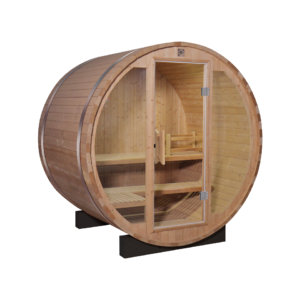How to Choose Your Barrel Sauna: Ultimate Guide
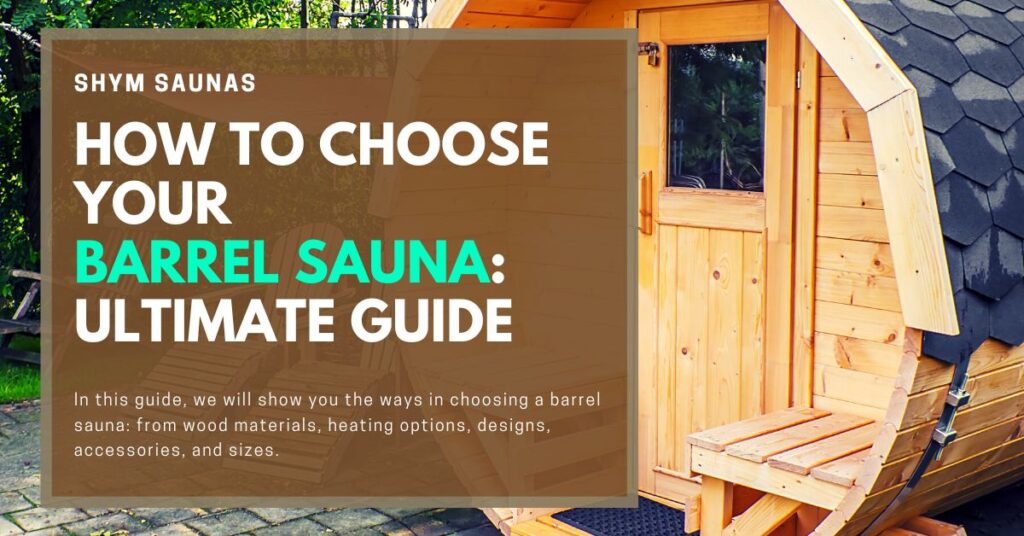
“How to choose a barrel sauna?” is a common question you may ask yourself if you’re planning to build one outside your peaceful home. However, building a sauna from scratch can be a demanding and expensive task to do alone. There is also a lot of room for error and getting your ventilation wrong can be dangerous.
Have you considered a barrel sauna? With these Do-It-Yourself sauna kits, you can build and relax in your sauna in no time! In this guide, we will show you the ways in choosing a barrel sauna: from wood materials and heating options to designs, accessories, and sizes.
What Is A Barrel Sauna?
As simple as it is named, a barrel sauna is a type of outdoor sauna that is shaped like a barrel. These saunas are cylinder-shaped with the use of long staves, which are long pieces of wood with chamfered edges that fit together and form the barrel shape.
The sauna is assembled by wrapping straps tightly around the circumference to keep the staves in place. Some barrel saunas are straight, while others bulge slightly in the middle, which defines the barrel as we commonly know it.
A barrel sauna is a perfect way to enjoy the outdoor sauna experience. As it is made of wood, a barrel sauna has a natural look and scent that fits in perfectly with any outdoor setting! (They can also be used indoors, of course.)
Barrel Sauna Design

Most Barrel Sauna designs come in a pre-fabricated kit that needs DIY assembly. A barrel sauna kit comes with partially pre-assembled parts and wooden panels, benches, an electric sauna stove or wood-burning heater, and windows and doors.
Complementary accessories such as sauna stones, headrests, clothing hooks, water buckets, ladles, and wooden footrests are also sometimes included.
The barrel shape of the sauna helps it to resist water damage and pests, making it a low-maintenance option. The barrel sauna also comes with support cradles made from a high-grade polymer that serves as the base and is placed on any flat surface. This makes it versatile for different types of locations such as your backyard, patio, or deck.
The wood selection for barrel saunas fares well as a sauna material as they are good heat insulators. Particularly, cedar wood is a popular wood for barrel saunas as it has superior resistance to water and insects. All these features make the barrel sauna a great choice for anyone looking for an easy-to-use and low-maintenance option.
As compared to traditional saunas, a barrel sauna is designed with a single-element structure, making it much simpler and more affordable. Traditional saunas have a multiple element structure: external cladding, frame, internal cladding, insulation, and even vapor barrier. This makes them more complex and expensive to build than barrel saunas.
Read More and Elevate Your Backyard with Barrel Sauna Benefits
How Does Barrel Sauna Work?
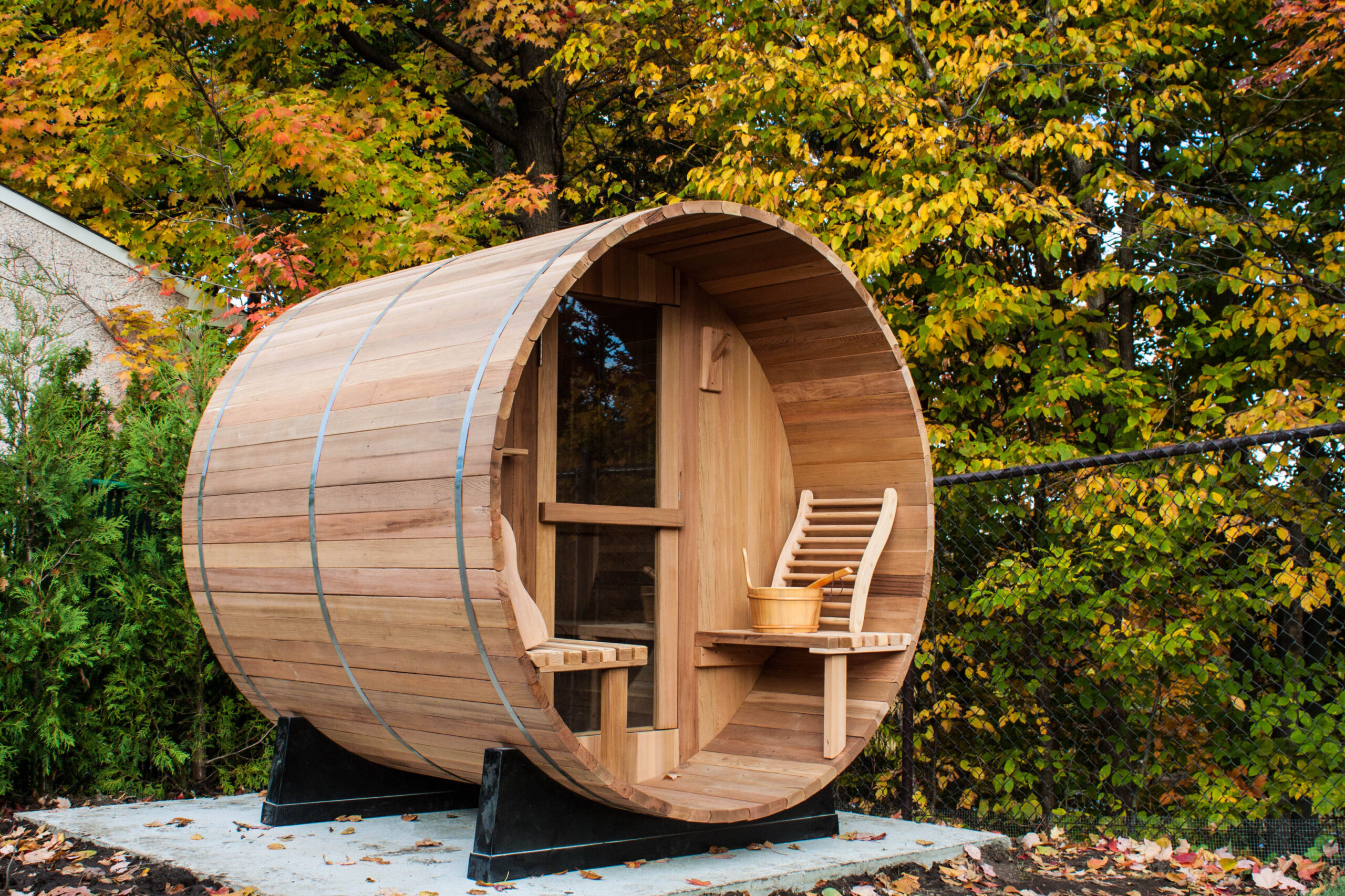
A barrel sauna works like a traditional sauna but has added features and benefits. Its unique shape and curvature help to evenly distribute the heat, making it more comfortable than a traditional sauna. By allowing the upper heat to be pushed down the sides and back into the sauna, it ensures that the higher temperatures are brought lower into the sauna. This way, the heat flows more evenly, making for a more comfortable and enjoyable experience.
Additionally, the barrel sauna can retain heat better than traditional saunas due to its superior insulation properties, meaning that you can enjoy the benefits of the sauna for longer.
When it comes to choosing a sauna, the barrel sauna is an excellent option for those who want to enjoy a more evenly distributed and comfortable heat.
How Long Does A Barrel Sauna Last and How to Protect It?
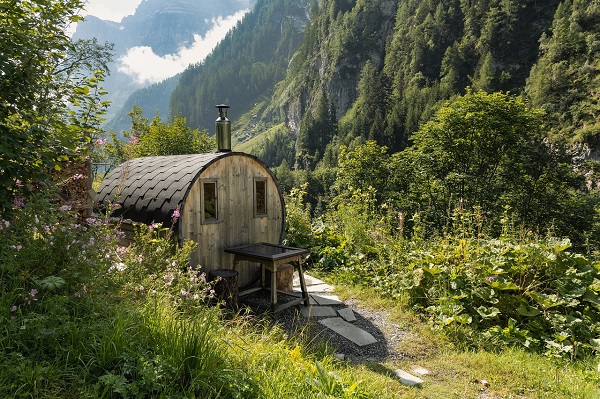
Barrel saunas are built to last, and can typically last from 15 to 20 years. But if you take good care of it and perform maintenance on a schedule, your barrel sauna could endure more years.
How to Protect Your Sauna
After a few years of having your barrel sauna outdoors, the wood may start to change color due to exposure to moisture and sunlight. Don’t worry, this is perfectly normal.
For outdoor barrel saunas, you can apply a high-quality semi-transparent stain or oil to maintain your outdoor barrel sauna every one to two years. Additionally, if you want to get your sauna looking new again, you can sand the surface with a smooth grit to refurbish the look of the wood before staining.
Although your barrel sauna is already made to handle tough weather conditions, you can keep the exterior wood to keep looking new with one or more of these options:
- Applying a wood-penetrating oil
- Cleaning with a pressure washer on the low setting cleaning.
- Use a stain on the exterior that has a UV inhibitor as additional protection from sunlight.
Related: Do Barrel Saunas Need a Roof? Exploring Weather Protection Options
Considerations in Choosing a Barrel Sauna
When choosing a barrel sauna, there are several important factors to consider to ensure you choose the best option for your needs. By taking the time to evaluate each of these options, you can find the perfect barrel sauna for your home or business.
#1 Where to Locate Your Sauna
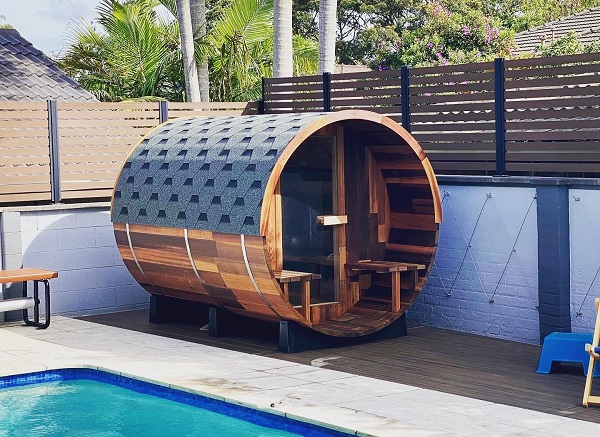
First and foremost, it is crucial to find the right location for your sauna before you start construction. If the ground is not level, this could cause problems with lining up the staves or getting the door to latch properly. If you cannot level the ground, you may need to use shims under the sauna cradles to make up for the unevenness.
There are many different materials you can use for the base of your sauna, but some of the most common include:
- Concrete
- Flagstone
- Wood/Deck
- Bricks and/or Pavers
- Compressed gravel
If you want to set your sauna indoors, any flooring type is suitable, except for carpeting. Remember that you may have leaks of condensed water on the floor.
When considering a location for a sauna always consider the following aspects:
- Privacy. Many people choose to have a sauna installed in areas where they can feel fully secluded and not being observed.
- Proximity to a water reservoir, shower, and possibly bathroom.
- Change room, or place where people could change their cloth for something more suitable for a sauna.
- Proximity to relaxation zone, tea zone, or area where you could have a rest between sauna sessions.
Beware: Never place your barrel sauna on bare earth.
Doing this will increase the risk of tipping and damage to the sauna. In addition, placing your barrel sauna on a hard surface will help to improve the efficiency of the sauna and make it easier to keep clean.
Looking for ideas on sauna layouts? Get inspired with Our Projects gallery!
#2 Indoor vs Outdoor Barrel Sauna
When it comes to owning a barrel sauna, there are two main options to choose from – indoor or outdoor.
When to consider an indoor sauna?
If you live in an apartment or somewhere where space is limited, then an indoor sauna is probably your best bet. Also, if you would like to have a minimal weather impact on your sauna, so that it lasts the longest, have your sauna indoor, there will be no rain or damaging sun.
When to consider an outdoor sauna?
On the other hand, if you have a bit more outdoor space to work with, building an outdoor sauna is a great option. Although outdoor saunas tend to be more authentic and closer to nature, they may not be as convenient as an indoor sauna.
Why Choose Indoor Saunas?
Several benefits come along with having an indoor sauna. One of the main advantages is that you don’t have to leave your home to enjoy your sauna session.
Additionally, having your showers and bathroom close by can be a major perk.
However, there are also some drawbacks associated with indoor saunas. For example, they can be quite expensive to install and maintain with the needed insulation, plumbing, and venting systems. Plus, if you live in a humid climate, the indoor sauna may not be ideal since it can make the space quite stuffy. Also, indoor sauna options are limited to electrically heated ones and not firewood.
Why Choose Outdoor Saunas?
An outdoor sauna can offer a more authentic and luxurious experience, especially if you’re fortunate to have access to bodies of water or other scenic outdoor spaces. The fresh air and natural surroundings can make the sauna experience even more relaxing and enjoyable.
Take note that there are a few things to keep in mind before investing in an outdoor sauna. For example, weather conditions can play a role in how often you’ll be able to use it.
If you live in an area with hot summers, your outdoor sauna might not get much use during the hot months. Additionally, outdoor saunas require more maintenance than indoor models, so be prepared to spend some time and effort keeping them clean and in good condition.
#3 Infrared sauna vs Traditional sauna

If you are looking for a sauna that has lower temperatures but can still penetrate your body with heat, then an infrared sauna is the best option for you. Infrared saunas are designed to be used indoors only, so keep that in mind.
On the other hand, if you prefer steam, higher temperatures, and a more social setting, then a traditional sauna is probably the best option for you. Also, traditional saunas can be enjoyed indoors or outdoors. Here are some key factors that differentiate a traditionally heated sauna from an infrared heated sauna:
| Traditional Sauna | Infrared Sauna | |
| Heating method | Conduction/Convection | Radiation |
| Temperature | Can heat above 85 °C (185 °F) | 50 °C to 65 °C (120 °F to 150 °F) |
| Energy Requirements | More power (up to 4.5 – 6 kW and higher) | Low power (about 1.6 kW) |
| Humidity | Higher Humidity | Low humidity |
Heating method
Traditional saunas work by transferring the heat from the air around you into your body. This is also accompanied by heat transfer that happens due to steam condensation on the surface of your skin. As a result, your body starts its natural cooling process, which brings blood closer to the skin’s surface and opens the pores to release sweat. Traditional saunas are simple but effective. A single heater is used to heat the air, and that hot air heats the user.
On the other hand, an infrared sauna session can feel very different than a traditional sauna session. For one, you don’t necessarily need to be in a steamy room to reap the benefits of an infrared sauna.
Infrared saunas work by emitting a wavelength of light that your body absorbs. This absorption causes your body to heat up, which then activates more pronounced sweating. Because you’re not dealing with a steamy environment, some people find infrared saunas to be more comfortable and tolerable than traditional saunas.
Temperature

The main differences between infrared saunas and traditional saunas are the temperature and the way the heat is transferred to the body. Traditional saunas can get very hot, sometimes reaching over 100 degrees Celsius. This can be too much for some people to handle.
Infrared saunas, on the other hand, use lower temperatures that are more comfortable. Even though the temperatures are lower, infrared saunas are still effective in sweating your body. Infrared saunas are a bit cooler than traditional saunas because they focus on heating the body itself, rather than the room.
Traditional saunas in contrast have a more natural way of heating your body, via surrounding hot air and the environment. There are also many health benefits from the use of traditional sauna that are not achieved with the use of an infrared sauna.
Humidity
Another important difference between traditional and infrared saunas is the level of humidity. Traditional saunas have much higher levels of humidity, which some people believe provides additional benefits such as opening pores and promoting better sleep.
Saunas that use infrared technology do not produce steam, thus having lower levels of humidity. People who enjoy using these saunas say that the sweating they induce can help detoxify the body and lead to weight loss.
However, it is often omitted that steam is the main contributor to raising the body temperature. As the steam condenses on the surface of the skin the heat is transferred from the steam to the body. This heat transfer is more efficient than from the dry hot air. So, if you target to maximise the health benefits from the use of the sauna and its hot temperature then the high humidity sauna is for you. Dr. Michael Ruscio has summarised well the health benefits of the use of the two types of saunas in his article “Infrared Saunas vs. Traditional: Which Is Better?”. It also had been backed up by scientific research.
#4 What Materials are Available for Barrel Saunas?

Cedar
There are a lot of different materials that can be used to build a barrel sauna. One of the most popular and traditional choices is cedar. Cedar is very durable and is known to withstand harsh outdoor conditions. It also has a natural resistance to decay.
Additionally, cedar won’t swell or shrink when exposed to extreme temperatures – making it ideal for use in a sauna. Not to mention, cedar is a great insulating material- it won’t get hot to the touch. There are two common types of cedar used:
Western Red Cedar
The Western Red Cedar is a type of tree that is native to the west coast of North America. It has a beautiful reddish color, and it is very strong and durable, thus known as high-quality material. This makes it an ideal material for building outdoor saunas.
Eastern White Cedar
If you’re looking for an environmentally friendly and sustainable option for your barrel sauna, eastern white cedar is another great choice. This tree species is shorter than western red cedar, but it grows back quickly – about every 35 years. Eastern white cedar has a pale brown or tan color, and it turns a beautiful silver-gray when left unfinished and exposed to the elements.
Nordic Spruce

Nordic Spruce is an excellent wood choice for saunas because of its high density and tightly ingrown structure. It is a popular sauna wood in Finland and other European countries because of its light coloring and therapeutic aroma. Also, the hydrocarbons in the Nordic Spruce make it a naturally insect-repellent wood.
Nordic spruce may contain little sap that can vary from each wood piece, but this is normal and not harmful. If spruce is thermally treated, you can’t have sap seepage.
The thermal treatment works as a process involving heat and steam. This improves the wood to be more stable and durable, resisting rot. This is a chemical-free and eco-friendly process that makes any wood a better and more stable material.
Hemlock
Hemlock wood is an excellent material to use for building barrel saunas. It is moisture-resistant and durable, making it ideal for withstanding the high temperatures and steam of a sauna.
Hemlock is also low in resin, meaning that it won’t release resin fumes into the air when heated. This makes it a good choice for people with allergies or sensitivities. Hemlock also has a faint scent, sometimes odorless, making your sauna smell fresh and clean.
There are three main types of hemlock – Canadian, Western, and Hem-Fir – which all have different benefits.
- Canadian Hemlock is one of the most popular choices because it is native to North America, has a uniform texture, and is very aesthetically pleasing.
- Western Hemlock is another great option that is native to the west coast of North America and pairs well with other woods like Western Red Cedar.
- Lastly, Hem-Fir is a combination of Western Hemlock and fir trees that makes for beautiful detail work in a sauna.
Aspen
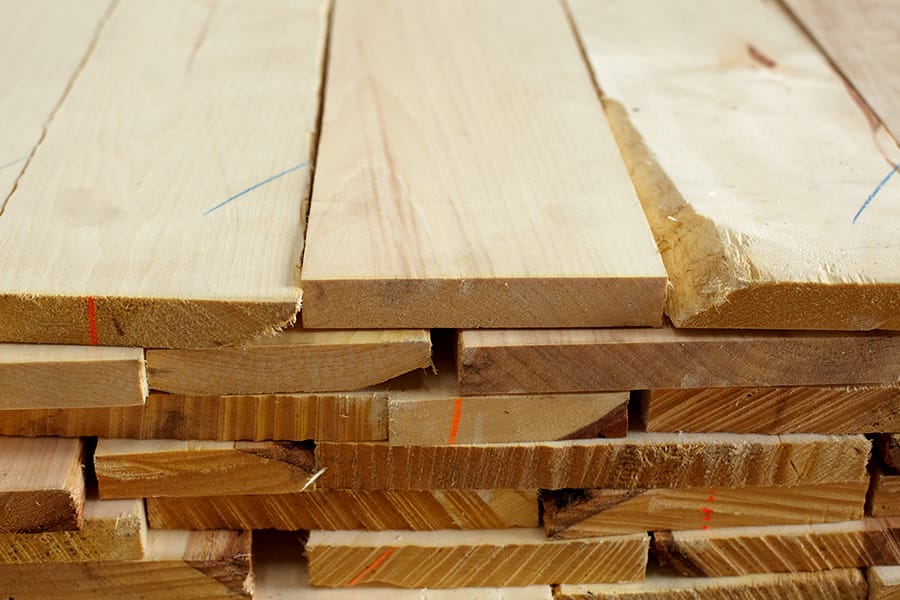
Aspen is a type of tree that is common in cooler regions of Asia and Europe. It is bright in color and belongs to the willow family. This wood is a popular material for saunas because of its moisture-resistant, resin-free, non-allergenic, and non-toxic, properties. It fares the outdoors well too, as it can withstand microorganism attacks.
Douglas Fir
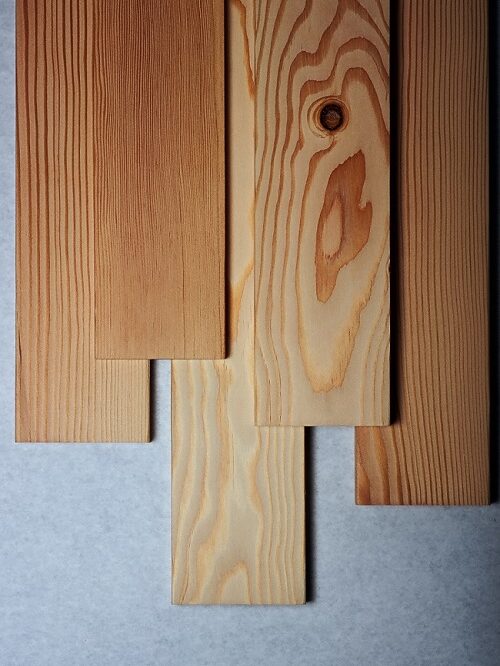
The Douglas Fir tree is a species of tree native to North America, commonly used for its wood that has good strength and appearance. The Douglas Fir has a light brown color with hints of yellow or red and has little to no scent. Its uniform appearance and straight grain make it a desirable choice for many applications.
Kiln-drying the wood prevents it from seeping resin, making it a popular choice for homes, furniture, and saunas.
Pine

Pine is one of the more affordable woods used in sauna construction. It is a darker-colored wood but typically has more wood knots as compared to spruce.
The knots are problems for pinewood when they tend to be large and loose. With a high resin content as well, pinewood can have dripping sap and unpleasant resin emissions. Pine can also warp and bend more easily than other sauna woods, making it less durable.
However, pine becomes a stronger and more durable wood type once it is thermally treated.
#5 How Many People Will Use the Barrel Sauna?
The number of people who can use a barrel sauna at one time will depend on the size of the barrel sauna. Smaller barrel saunas can accommodate 2 to 4 people, while larger ones can fit up to 8 individuals. If you have a lot of friends who also enjoy using saunas, the 8-person sauna can be a great investment!
Barrel saunas are named and designated according to the number of people that can use the sauna at the same time. You can see barrel saunas named two-person, four-person, six-person, and eight-person barrel saunas. Custom barrel saunas can be made to accommodate even more people, but they may be more difficult to heat.
The main question to ask when choosing a sauna is how many people will we have in our sauna at a time? The answer can be 2, 4, or more. This will define the dimensions of the sauna to choose from.
Another important question is how do you intend to use the sauna? Do you plan to do some light stretches in the sauna? Many people also like to use sauna whisks in the sauna to maximise health benefits. In both cases, you may need to consider the larger sauna size options.
#6 How Much Space Do You Need for a Home Sauna?

When selecting a sauna, you should consider the available space in your home. This is especially important if you are considering an outdoor sauna, as you will need to factor in the size of your platform and the available space to place your barrel sauna. In particular, it is the footprint of the sauna and its height that needs to be considered.
Many saunas vary in shape and size. More traditional saunas are rectangular, but it is common to find all kinds of sauna shapes these days including round barrels, square barrels, and even oval. There is probably not much difference in terms of functionality of the sauna for different shapes, as they all work similarly.
As the shape of the sauna changes so does the complexity of the structure and its components, which leads to a difference in price. In general, all sauna shapes will require a solid base platform, whether it is a slab or pavers, it will need to be leveled.
Regarding the size of the sauna, the sauna can be as large or as small as one wants it to be. Important to note that the larger saunas will be more expensive to buy, build and maintain. It will also be more costly to run in terms of energy spent on heating. The larger saunas will require more space, so make sure to check the numbers and dimensions for your specific make and model before you buy it.
If you are in the market for a firewood-heated sauna, make sure to take into account the height of the flue and the clearance from the nearby buildings and structures. It can also be a good idea to check with your neighbors if they will be ok with you running the firewood heater occasionally and the associated smoke that may be blown their way.
#7 What Type of Sauna Heater Should I Choose?

When it comes to heating a barrel sauna, there are two main options: wood-fired heating or electric heating. Both have their own set of benefits and drawbacks, so it’s important to choose the option that best suits your budget, your resources, and your needs.
Electric Sauna Heaters
Electric heaters are much easier to use and don’t require as much upkeep. They’re also generally more efficient than wood-fired heaters, making them a good choice for faster heating and precise control.
An electric heater for a barrel sauna is a great choice if you want excellent temperature control. For example, Harvia Sauna Heaters are known for convenient and easy control. It often heats up quicker than a wood-fired heater, and it’s also easier to make small changes in the temperature. However, you’ll need reliable access to an electric grid to use an electrically heated sauna. Sometimes, a 3-phase power supply is required and not every house can supply it.
An electric sauna heater is an easy-to-use option for heating your barrel sauna. Additionally, electric sauna heaters do not produce any exhaust or fumes, making them a safer and somewhat more environmentally friendly option. Your friends and neighbors will also appreciate the lack of smoke and fumes coming from your electric sauna heater!
Selecting an Electric Sauna
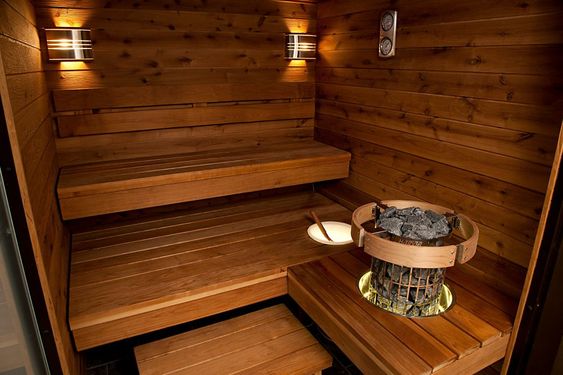
There are a few key things you’ll want to keep in mind when selecting an electric sauna heater. First, consider the size of your sauna. The internal volume will dictate which heater you’ll need. Most heaters come with power requirements and size guidelines in the product specifications.
Another thing to keep in mind is how often you plan on using the sauna. If you’re a regular sauna-goer, you’ll want a heater that can withstand heavy use. On the other hand, if you only plan on using it occasionally, you can get away with a less durable heater.
Finally, take a look at the different features available and pick the ones that are most important to you. Some heaters come with additional features like built-in thermostats or shut-off timers. Others have special heating elements that create a more even distribution of heat.
This table will show a rough guide on which electric heater you should opt for.
| Heater Output | 4.5 kW | 6 kW | 9 kW | 10.5 kW |
| Sauna Capacity | 3-6 m3 | 5–8 m3 | 8–14 m3 | 10–18 m3 |
Take note, however, when installing an electric heater, it must be done by a qualified electrician. Otherwise, it is an illegal installation that is not covered by the manufacturer’s and supplier’s warranties.
Additionally, they will be able to guide the best way to install the heater for your barrel sauna. Having an initial consultation before beginning the installation process is worthwhile and can save you time and money in the long run.
Wood-Fired Heater
Wood-fired heaters are the most traditional option, and they offer several advantages. They’re usually more expensive than electric heaters, and they provide a more natural experience. However, wood-fired heaters can be tricky to operate, and they require more attention during the operation.
Wood-fired sauna stoves are gaining popularity again because they hearken back to the ancient origins of saunas. People who want a classic, organic experience that connects them with nature often choose wood-fired sauna stoves.
Although they require more maintenance than other types of sauna stoves. Wood-fired saunas require a flue and regularly checking for fire hazards. Nevertheless, wood-fired sauna stoves are perfect for those who have their saunas in remote locations. This is because they don’t rely on an electrical grid, which may not be accessible in rural areas.
A wood-fired heater for barrel saunas is certainly a great way to enjoy the comforting smell of burning wood. However, buying wood as fuel for your wood-fired sauna heater can be costly. If you are near a sustainable and cheap (or free) wood supply, then operating your wood-fired sauna heater will be very affordable.
Ultimately, the decision of whether to use an electric sauna heater or a wood-fired sauna heater depends on your personal preferences. If you prefer the convenience of electricity, then an electric heater is the way to go. However, if you prefer the ancient ambiance of wood and a classic sauna experience with more control over your heater and heat, then a wood-fired heater is the better option.
Related: Electric vs. Firewood Sauna Heaters – What’s Right for You?
Selecting a wood-fired sauna

When trying to figure out which wood-fired heater is right for your barrel sauna, the size of the sauna itself is the most important factor. Each type and size of heater has specific requirements in terms of the size of the sauna it can heat effectively.
Also, a big factor to consider is whether you would prefer your firewood heater to source air for combustion from the interior of your sauna or whether you would rather have it drawn from outside of your sauna. Both options are possible and have their advantages and disadvantages.
Often for a small barrel sauna, it is recommended to have external air and firewood intake due to space limitations. Internal air intake (from the inside space of the sauna) is also a good option; however, it will require more accurately designed ventilation. This is to make sure that people inside the sauna do not compete for air with the heater that requires air for burning the firewood.
Additionally, some heaters will require heat shielding to protect the barrels from the intense heat. You can find all of this information in the product specification table on each heater’s product page.
#8 Do I Need a Customized Barrel Sauna?
When it comes to barrel saunas, there are a lot of options to choose from in terms of size, wood material, heating options, accessories, and more. However, one thing that is not so customizable is the design and manufacturing process.
Barrel saunas are designed and manufactured to be built easily from a standard set of instructions. This means that while you may not be able to customize your sauna exactly to your specifications, you will still be able to choose from a wide range of options to get the perfect sauna for your needs.
The sauna experience can be enhanced with additional features such as a panoramic glass barrel sauna or a barrel sauna with a porch, and/ or a changeroom.
Panoramic Barrel Sauna
A panoramic barrel sauna gives you an excellent view of the outdoors and can be a very relaxing experience, especially if you build it in a scenic location. The dome-shaped glass also provides more space and better lighting.
Barrel Sauna with Porch
If you want additional seating, you could opt for a barrel sauna with a porch. This would be a great place to cool down before going into another session in the sauna. The dedicated area for resting in between sauna sessions is a necessity and when there is a limitation with having such an area, the porch as part of the sauna can be a great option.
Related Article: Our Projects: Create the Perfect Home Spa: Sauna Installation in Sydney
Barrel Sauna with Changeroom
A bit similar to the porch is a change room. This is a small inner room where you can change and rest before or after your session. Not only an extra feature but a change room can be used as the rest area to cool down in between sessions.
Barrel Sauna Cost
How Much Does a Barrel Sauna Cost?
| Sauna Sizes | Price Range |
| 2 Person Sauna:180 cm Diameter x 150 cm L | $5,000 to $6,500 |
| 4 Person Sauna: 180 cm Diameter x 180 cm L (with 600 mm porch or without) | $6,000 to $8,000 |
| 6-8 Person Sauna: 210 cm or Diameter x 180-240 cm L x 210 cm H | $7,500 to $9,500 |
| 4-10 person sauna: 210 cm W x 270 cm L x 210 cm H | $9,000 to $11,000 |
Prices are in Australian Dollars and do not include the heater or shingles.
Saunas come in a variety of sizes to accommodate different numbers of people, as well as different budgets. A 2-person sauna may cost anywhere from $5,000 to $6,500, while a 4-person sauna with or without a porch may cost between $6,000 and $8,000.
For a larger sauna that can accommodate 6-8 people, prices may range from $7,500 to $9,500. Finally, a sauna that can seat 4-10 people may cost between $9,000 and $11,000. (2024 prices)
When choosing a sauna, it is important to consider how many people will be using it regularly, as well as what size will fit comfortably in the space you have available. To know how much it costs to build your sauna, make sure to consider a ton of tools, devices, and accessories. Don’t forget to account for costs for labor, shipping, and others.
How Much Will a Sauna Heater Cost?

The cost of a sauna heater will depend on the type of heater you choose. A wood-fired sauna heater can cost anywhere from $1,500 to $10,000, while an electric sauna heater will cost between $400 and $4,500. Keep in mind that some sauna suppliers include a heater with the package, while others allow you to choose your own.
The installation cost for a wood-fired sauna heater may be less expensive since you won’t need an electrician to help with the installation. However, it’s important to consult your supplier about firewood heaters as there could be some serious health and safety concerns involved with operating one.
It’s essential to get the installation of either type of heater right from the start. Additionally, the operational costs for either type of heater will vary depending on your electricity rates and firewood costs in your area.
FAQs
How Much Does A Barrel Sauna Weigh?
A barrel sauna typically weighs between 250 and 350 kilograms, although larger ones can weigh up to 500 kilograms. The weight of the sauna depends mainly on the type of wood it is made from and its physical size. Barrel saunas are usually made from softwood like cedar or spruce, which are sturdy and durable but are mostly lightweight as compared to hardwood. Its parts will be easy to disassemble and carry in case you will be transferring your barrel sauna.
How do you install the Barrel Sauna?
Here are the basic steps in building your barrel sauna.
- Base Installation

Make sure the space for installation is nice and flat. Next, lay out the bases squarely to make sure you don’t have a twisted sauna. Secure the bottom stave and then recheck the diagonals after securing the bottom stave to make sure the bases are squared with each other.
Stack the staves located at the bottom part, about six staves on each side of the bottom stave. Make sure the grooves are aligned properly so the front and back panels can be installed easily and properly. Finally, secure the staves with screws
- Front and Back Panel Assembly:
The next step is to start preparing your front and back panels. It is important to pay attention to the grooves when you are putting these together. It is also very important that you use screws that are long enough to go through the thickness of the wood and into the support beam behind it. To guide the alignment between the two walls, install the topmost stave temporarily.
- Staves Assembly:

Proceed with installing the staves on each side. They should be then secured by screws, except for the top staves to accommodate for adjustments later. Make sure that the screws are long enough to go through the thickness of the wood and into the wall behind it.
The top staves are typically prebuilt, especially for wood-fired saunas as they have a pre-cut hole for the firewood heater flue.
- Floorboards:
The floorboards need to be installed next. Make sure that all of the boards are level and flush with each other.
- Heater Assembly:
The heater needs to be installed next. Make sure that you follow the instructions that come with the heater. It is important to make sure that the wiring is done correctly by a qualified electrician and that the heater is properly grounded.
For a wood-fired sauna, make sure that the hole for the chimney aligns straight to the chimney hole so that the duct is installed straight. If not aligned properly, this is where you can adjust the top staves. It is also essential to have sufficient clearance from any part of the heater to the timber elements of the sauna. Check the manual or contact your supplier.
- Securing the Straps:
The next step is to secure the straps. Before tightening these straps, loosen the screws that fasten the staves. This will ensure that any gaps in between staves will be removed as the straps are tightened.
After securing the straps, you can proceed to position the heater in its final place.
- Inside Bench Assembly:
The inside bench needs to be assembled next. It is important to make sure that all of the boards are level and flush with each other.
- Finishing Touches

The last step is to add any finishing touches. This might include adding a bitumen shingle to the roof or adding some accessories to the inside of the sauna.
Read More: Assemble Your Own Square Barrel Sauna with Firewood Heater: A Quick Step-by-Step Guide
Do Barrel Saunas Need Insulation?
Barrel saunas do not need insulation like other types of saunas. Barrel saunas are a type of sauna that is designed to retain and maximize heat without the need for insulation. This is achieved through the thickness of the wood that is used. The typical thickness of staves is 38-40 mm. This is enough to provide good insulation as is.
Their circular design causes warm air to rise and cold air to go down, so the air circulates constantly as it is being reheated. This maintains the internal temperature more efficiently, and less heat is lost overall.
Barrel saunas have fewer interior walls than cabin-style saunas, so there is less area to heat. The staves are also capable of insulating the sauna given their properties and their thickness. By fitting together tightly, they help to keep the heat inside the sauna.
Barrel saunas are an ideal choice for those who want to enjoy the benefits of a sauna without having to worry about insulation. Thanks to their design, they can retain heat effectively and provide a soothing and relaxing experience.
Do Barrel Saunas Need a Roof?

If you live in an area with a lot of rainfall, then a waterproof roof is essential. There are several different options available when it comes to waterproofing your sauna roof, so you can choose the one that best suits your needs.
Bitumen Shingles
This is a fairly straightforward process, and it will effectively keep water from seeping into your sauna.
Raincoats or Jackets
Another option is to use specially-designed raincoats or jackets for your sauna. These are made from waterproof materials and will protect your sauna from the elements.
Metal Sheet Roofing
If you want a more permanent solution, you can install metal sheet roofing. This is a more involved process, but it will create a waterproof barrier that will last for many years.
Shed/ Roof Structure
Finally, you can build an independent roof structure or shed to house your sauna. This is the most expensive option, but it will provide the ultimate protection for the elements.
Note: Avoid using a pergola or gazebo if you plan to have a wood-fired sauna. These structures are not designed to withstand the heat of a fireplace, and they could pose a serious safety hazard. Unless the flue is extended through the roof of the gazebo with the appropriate fire safety measures.
Do you need plumbing for a sauna?
When it comes to barrel saunas, there is no plumbing requirement unless you want a floor drain. This would only be the case if you were to install the sauna indoors. If you’re planning on installing the sauna outdoors, then drainage and plumbing will not be an issue.
Where to Buy Barrel Sauna?
You can buy barrel sauna in Australia from Shymsaunas. We provide premium quality Western Cedar or Spruce Saunas and Hot Tubs. We stand by the quality of our products and know that you will be happy with your purchase. Our saunas are easy to set up and use, and we offer a variety of sizes and styles to suit any need. Don’t miss out on this amazing opportunity to improve your health and wellbeing – order your sauna today!
In Closing
Barrel saunas are a great, affordable way to get all of the benefits of a sauna. They are easy to install and can be used for socialising with friends or family. If you’re interested in installing one of your own, be sure to check out our saunas and accessories: bathtubs, electric sauna heaters, lighting, and electronic devices for all of your sauna needs! Thanks for following our blog post on barrel saunas – we hope you found it helpful.




